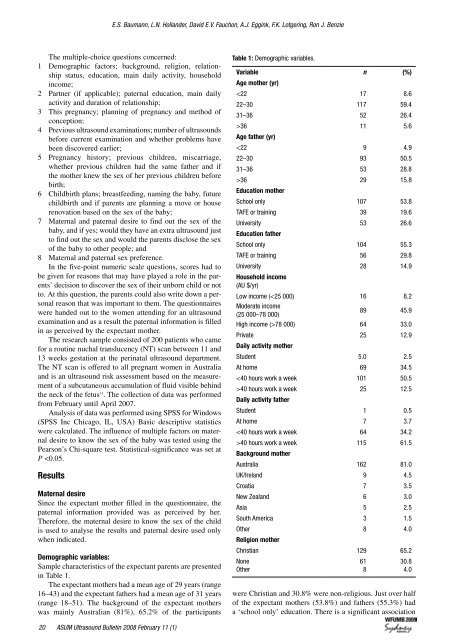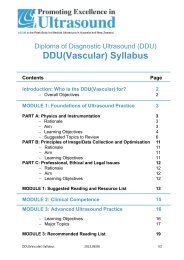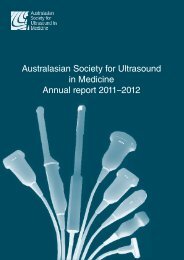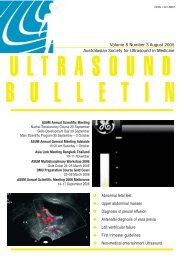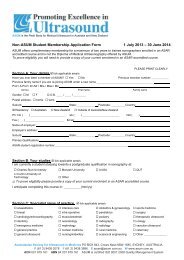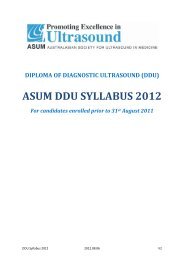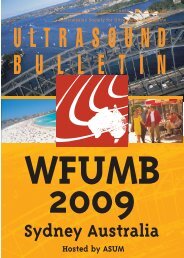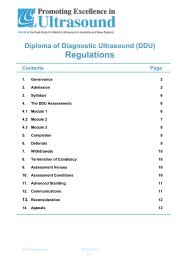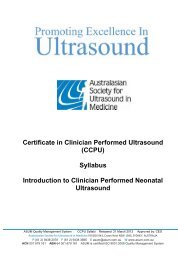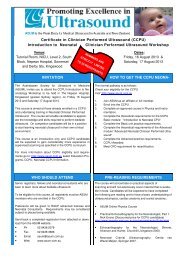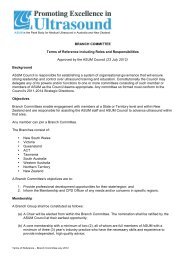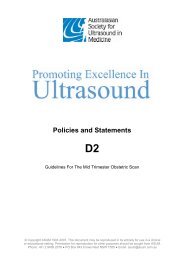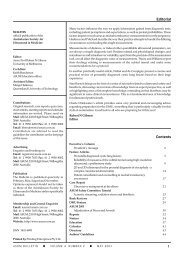Volume 11 Issue 1 (February) - Australasian Society for Ultrasound ...
Volume 11 Issue 1 (February) - Australasian Society for Ultrasound ...
Volume 11 Issue 1 (February) - Australasian Society for Ultrasound ...
Create successful ePaper yourself
Turn your PDF publications into a flip-book with our unique Google optimized e-Paper software.
E.S. Baumann, L.N. Hollander, David E.V. Fauchon, A.J. Eggink, F.K. Lotgering, Ron J. Benzie<br />
The multiple-choice questions concerned:<br />
1 Demographic factors; background, religion, relationship<br />
status, education, main daily activity, household<br />
income;<br />
2 Partner (if applicable); paternal education, main daily<br />
activity and duration of relationship;<br />
3 This pregnancy; planning of pregnancy and method of<br />
conception;<br />
4 Previous ultrasound examinations; number of ultrasounds<br />
be<strong>for</strong>e current examination and whether problems have<br />
been discovered earlier;<br />
5 Pregnancy history; previous children, miscarriage,<br />
whether previous children had the same father and if<br />
the mother knew the sex of her previous children be<strong>for</strong>e<br />
birth;<br />
6 Childbirth plans; breastfeeding, naming the baby, future<br />
childbirth and if parents are planning a move or house<br />
renovation based on the sex of the baby;<br />
7 Maternal and paternal desire to find out the sex of the<br />
baby, and if yes; would they have an extra ultrasound just<br />
to find out the sex and would the parents disclose the sex<br />
of the baby to other people; and<br />
8 Maternal and paternal sex preference.<br />
In the five-point numeric scale questions, scores had to<br />
be given <strong>for</strong> reasons that may have played a role in the parents’<br />
decision to discover the sex of their unborn child or not<br />
to. At this question, the parents could also write down a personal<br />
reason that was important to them. The questionnaires<br />
were handed out to the women attending <strong>for</strong> an ultrasound<br />
examination and as a result the paternal in<strong>for</strong>mation is filled<br />
in as perceived by the expectant mother.<br />
The research sample consisted of 200 patients who came<br />
<strong>for</strong> a routine nuchal translucency (NT) scan between <strong>11</strong> and<br />
13 weeks gestation at the perinatal ultrasound department.<br />
The NT scan is offered to all pregnant women in Australia<br />
and is an ultrasound risk assessment based on the measurement<br />
of a subcutaneous accumulation of fluid visible behind<br />
the neck of the fetus <strong>11</strong> . The collection of data was per<strong>for</strong>med<br />
from <strong>February</strong> until April 2007.<br />
Analysis of data was per<strong>for</strong>med using SPSS <strong>for</strong> Windows<br />
(SPSS Inc Chicago, IL, USA) Basic descriptive statistics<br />
were calculated. The influence of multiple factors on maternal<br />
desire to know the sex of the baby was tested using the<br />
Pearson’s Chi-square test. Statistical-significance was set at<br />
P


